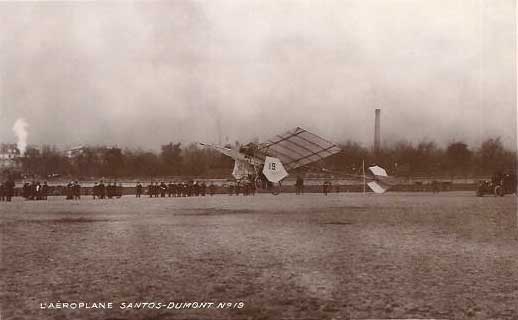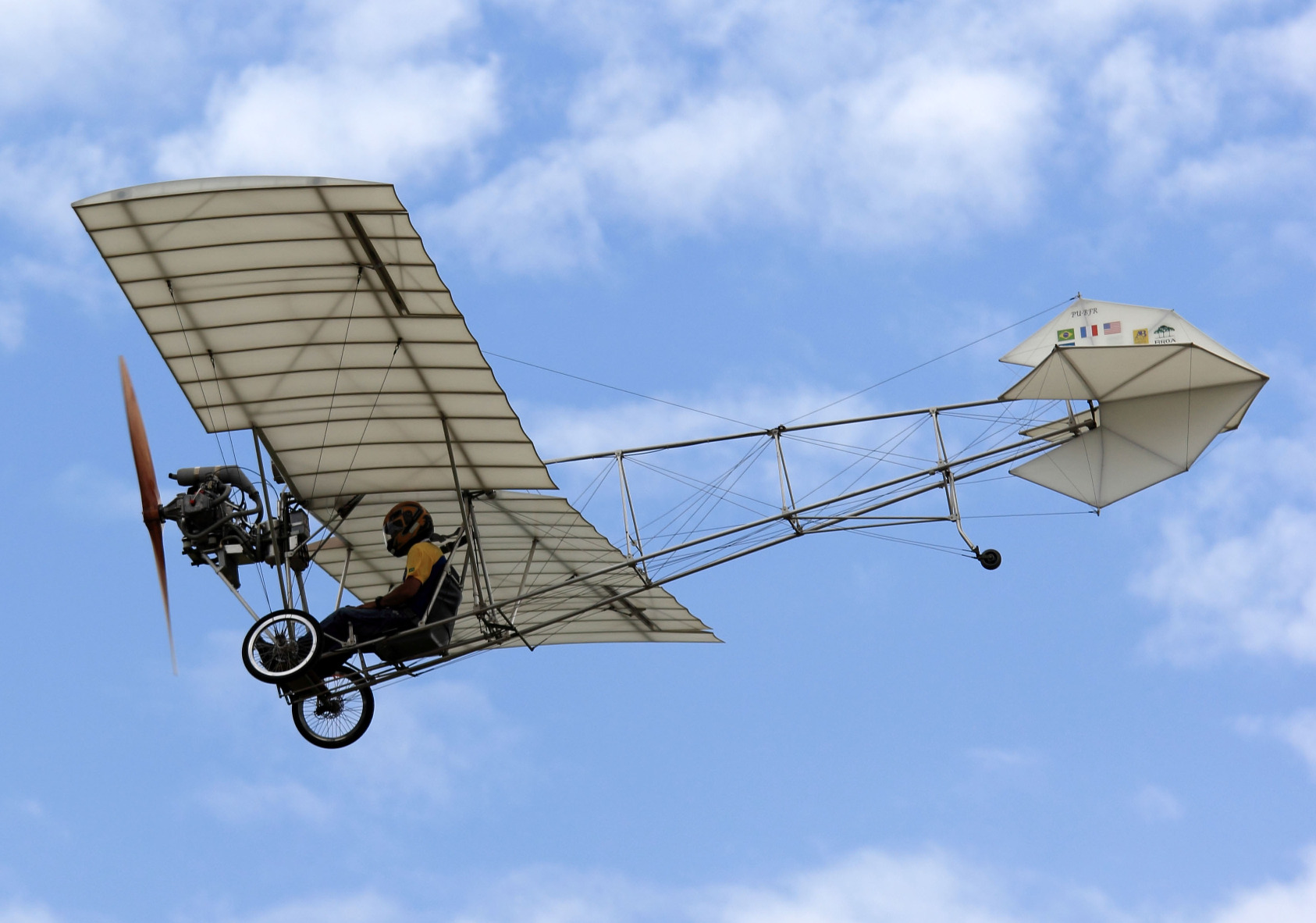Santos-Dumont Demoiselle on:
[Wikipedia]
[Google]
[Amazon]
The Santos-Dumont ''Demoiselle'' was a series of aircraft built in France by world aviation pioneer
 The first aircraft of the type was the Santos-Dumont No. 19, which was built to attempt to win the
''Grand Prix d'Aviation offered for a one kilometre closed-circuit flight. Powered by a 15 kW (20 hp) air-cooled Dutheil & Chalmers
The first aircraft of the type was the Santos-Dumont No. 19, which was built to attempt to win the
''Grand Prix d'Aviation offered for a one kilometre closed-circuit flight. Powered by a 15 kW (20 hp) air-cooled Dutheil & Chalmers  Later, Santos-Dumont made a number of modifications: he repositioned the engine, placing it below the wing in front of the pilot, fitted a different propeller and removed the forward elevator and rudders.
Later, Santos-Dumont made a number of modifications: he repositioned the engine, placing it below the wing in front of the pilot, fitted a different propeller and removed the forward elevator and rudders.
''Flight, 2 October 1909, pp. 603–6 All versions had a pair of lightweight thin-tube radiators mounted under the wing, running the entire meter chord of the wing. It used

Alberto Santos-Dumont
Alberto Santos-Dumont ( Palmira, 20 July 1873 — Guarujá, 23 July 1932) was a Brazilian aeronaut, sportsman, inventor, and one of the few people to have contributed significantly to the early development of both lighter-than-air and heavie ...
. They were light-weight monoplanes with a wire-braced wing mounted above an open-framework fuselage built from bamboo. The pilot's seat was below the wing and between the main wheels of the undercarriage. The rear end of the boom carried a tailwheel and a cruciform tail __NOTOC__
The cruciform tail is an aircraft empennage configuration which, when viewed from the aircraft's front or rear, looks much like a cross. The usual arrangement is to have the horizontal stabilizer intersect the vertical tail somewhere ...
. The name is a synonym for "jeune fille"—young girl or woman—but also the common name in French for a Damselfly
Damselflies are flying insects of the suborder Zygoptera in the order Odonata. They are similar to dragonflies, which constitute the other odonatan suborder, Anisoptera, but are smaller and have slimmer bodies. Most species fold the wings along ...
.
No. 19
 The first aircraft of the type was the Santos-Dumont No. 19, which was built to attempt to win the
''Grand Prix d'Aviation offered for a one kilometre closed-circuit flight. Powered by a 15 kW (20 hp) air-cooled Dutheil & Chalmers
The first aircraft of the type was the Santos-Dumont No. 19, which was built to attempt to win the
''Grand Prix d'Aviation offered for a one kilometre closed-circuit flight. Powered by a 15 kW (20 hp) air-cooled Dutheil & Chalmers flat-twin engine
A flat-twin engine is a two-cylinder internal combustion engine with the cylinders on opposite sides of the crankshaft. The most common type of flat-twin engine is the boxer-twin engine, where both pistons move inwards and outwards at the same ti ...
mounted on the leading edge of the wing, it had a wingspan of 5.1 m. (16 ft 9 in), was 8 m (26 ft 3 in) long and weighed only 56 kg (123 lb) including fuel. It had a pair of hexagonal rudders below the wing on either side of the pilot, a forward mounted hexagonal elevator in front of the pilot and a cruciform tail which, like the boxkite-style canard surfaces on the earlier 14-bis
The ''14-bis'' (french: Quatorze-bis), (), also known as ("bird of prey" in French), was a pioneer era, canard-style biplane designed and built by Brazilian aviation pioneer Alberto Santos-Dumont. In 1906, near Paris, the ''14-bis'' made a m ...
biplane of 1906, pivoted on a universal joint
A universal joint (also called a universal coupling or U-joint) is a joint or coupling connecting rigid shafts whose axes are inclined to each other. It is commonly used in shafts that transmit rotary motion. It consists of a pair of hinges ...
to function both as elevator
An elevator or lift is a cable-assisted, hydraulic cylinder-assisted, or roller-track assisted machine that vertically transports people or freight between floors, levels, or decks of a building, vessel, or other structure. They a ...
and rudder mounted at the end of a substantial single boom. There was no provision for lateral control. The undercarriage consisted of a pair of wheels in front of the pilot and a third behind, supplemented by a tailskid.
Santos-Dumont made three flights on 17 November 1907 at Issy-les-Moulineaux
Issy-les-Moulineaux () is a commune in the southwestern suburban area of Paris, France, lying on the left bank of the river Seine. Its citizens are called ''Isséens'' in French. It is one of Paris' entrances and is located from Notre-Dame Cat ...
.
 Later, Santos-Dumont made a number of modifications: he repositioned the engine, placing it below the wing in front of the pilot, fitted a different propeller and removed the forward elevator and rudders.
Later, Santos-Dumont made a number of modifications: he repositioned the engine, placing it below the wing in front of the pilot, fitted a different propeller and removed the forward elevator and rudders.
No. 20
Santos-Dumont's next aircraft, the Demoiselle No. 20, was first flown with an 18 kW (24-hp) Dutheil et Chalmers later replaced by a 22 kW (30 hp)Darracq
A Darracq and Company Limited owned a French manufacturer of motor vehicles and aero engines in Suresnes, near Paris. The French enterprise, known at first as A. Darracq et Cie, was founded in 1896 by Alexandre Darracq after he sold his Gladi ...
-built liquid-cooled opposed twin engine of approximately 3.2-litre displacement. The fuselage consisted of three bamboo tubes forming the primary longerons, of about 5 cm (2 in) diameter, connected by oval steel tubes. For ease of transportation the bamboo tubes were divided into two sections, joined together by brass sockets. The parallel-chord wings had two spar
SPAR, originally DESPAR, styled as DE SPAR, is a Dutch multinational that provides branding, supplies and support services for independently owned and operated food retail stores. It was founded in the Netherlands in 1932, by Adriaan van Well, ...
s made of ash and bamboo ribs Santos-Dumont "Demoiselle"''Flight, 2 October 1909, pp. 603–6 All versions had a pair of lightweight thin-tube radiators mounted under the wing, running the entire meter chord of the wing. It used
wing warping
Wing warping was an early system for lateral (roll) control of a fixed-wing aircraft. The technique, used and patented by the Wright brothers, consisted of a system of pulleys and cables to twist the trailing edges of the wings in opposite direc ...
for lateral control, operated from a transverse-pivoting joystick that would fit into a long, vertical pocket added to the jacket's back that the pilot would wear to fly the aircraft, "leaning into the turn" as either a bicycle rider would do for higher-velocity turns; or as Glenn Curtiss
Glenn Hammond Curtiss (May 21, 1878 – July 23, 1930) was an American aviation and motorcycling pioneer, and a founder of the U.S. aircraft industry. He began his career as a bicycle racer and builder before moving on to motorcycles. As early a ...
did with the transverse "rocking-cradle armrest" apparatus on the AEA June Bug
The ''June Bug'' (or ''Aerodrome #3'') was an American "pioneer era" aircraft designed and flown by Glenn H. Curtiss and built by the Aerial Experiment Association (A.E.A) in 1908. The ''June Bug'' is famous for winning the first aeronautical ...
in 1908. A similar system was used by Santos-Dumont in November 1906 to likewise operate the interplane ailerons on the final version of his ''Quatorze-bis'' pioneering canard biplane. The initial #20 Demoiselle's wing-warping arrangement also possessed control cabling that only pulled down alternately on the outer section of the rear wing spar with no "upwards" warp capability.
The Demoiselle was the last aircraft built by Santos-Dumont. He performed flights with it in Paris, and made trips to nearby places. Flights were continued at various times through 1909, including a cross-country flight with stages of about 8 km (5 mi) from St. Cyr to Buc on 13 September 1909, returning the following day, and another on 17 September 1909 of 18 km in 16 min. The aircraft was exhibited on the Clément-Bayard
Clément-Bayard, Bayard-Clément, was a French manufacturer of automobiles, aeroplanes and airships founded in 1903 by entrepreneur Gustave Adolphe Clément. Clément obtained consent from the Conseil d'Etat to change his name to that of his b ...
stand at the Paris Aéro Salon in October 1909 and it was announced that a production run of 100 aircraft was planned. However, only 50 were actually built, of which only 15 were sold, at a price of 7,500 francs for each airframe.. It was offered with a choice of three engines: Clement 20 hp; Wright 4-cyl 30 hp (Clement-Bayard had the license to manufacture Wright engines); and Clement-Bayard 40 hp designed by Pierre Clerget. It achieved 120 km/h.
The French pioneer aviator Roland Garros learned to fly in a Demoiselle at a flight school established by Clement Bayard, and later flew one at Belmont Park, New York in 1910. The June 1910 edition of ''Popular Mechanics
''Popular Mechanics'' (sometimes PM or PopMech) is a magazine of popular science and technology, featuring automotive, home, outdoor, electronics, science, do-it-yourself, and technology topics. Military topics, aviation and transportation o ...
'' published drawings of the Demoiselle and wrote "This machine is better than any other which has ever been built, for those who wish to reach results with the least possible expense and with a minimum of experimenting." American companies sold drawings and parts of Demoiselle for several years thereafter. Santos-Dumont was so enthusiastic about aviation that he released the drawings of Demoiselle for nothing, thinking that aviation would be the cause of a new prosperous era for mankind. The airplane received 300 copies across Europe and USA. An example of a Demoiselle with a Darracq engine is preserved in the '' Musée de l'Air et de l'Espace''. A flyable replica was built by Personal Plane Services Ltd for the 1965 film ''Those Magnificent Men in Their Flying Machines
''Those Magnificent Men in their Flying Machines; Or, How I Flew from London to Paris in 25 Hours and 11 Minutes'' is a 1965 British period comedy film that satirizes the early years of aviation. Directed and co-written by Ken Annakin, the film ...
'' and others have been built since then. Examples are on display at the Le Bourget Paris Air and Space Museum, The Brooklands Museum in Weybridge, Surrey, England, The Old Rhinebeck Aerodrome in Red Hook, New York and others.
Specifications (No. 20)

References
Sources
* * * * * *External links
{{Santos-Dumont aircraft Demoiselle 1900s French experimental aircraft Aircraft first flown in 1907 1910s French sport aircraft Ultralight aircraft High-wing aircraft Single-engined tractor aircraft